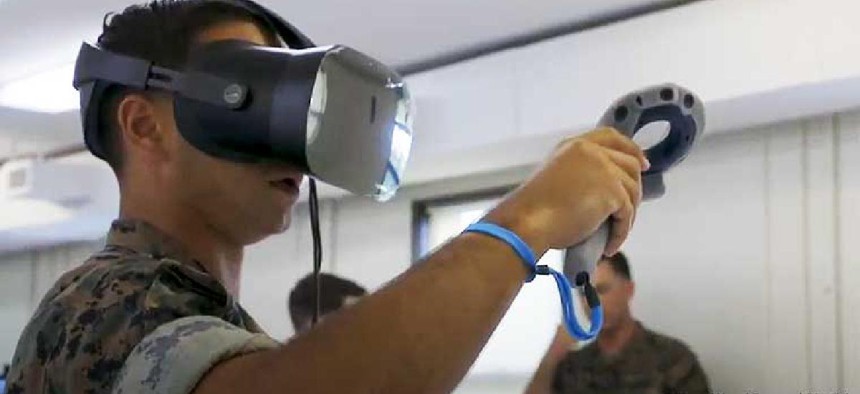VR, AR training helps forward observers direct fire support
The Office of Naval Research has developed augmented and virtual reality tools to make it easier to train the Marines who help protect infantry by keeping an eye on the ground situation and calling in necessary air artillery, mortar and naval gunfire.
The Office of Naval Research has developed augmented and virtual reality tools to make it easier to train the Marines who help protect infantry by keeping an eye on the ground situation and calling in necessary air artillery, mortar and naval gunfire.
Working from forward positions, Joint Terminal Attack Controllers (JTAC) direct combat aircraft in support of offensive operations, and Fire Support Marines adjust artillery and naval surface fire support. Both call for the use of sophisticated reconnaissance and range-finding technology while coordinating fire support from multiple assets.
The JTAC Virtual Trainer (JVT) and 3D Warfighter Augmented Reality (WAR) give Marines a way to practice their skills without participating in live-fire exercises involving expensive ordnance and aircraft or spending time in large indoor simulators that require scheduling, a building and a staff, according to a recent ONR article.
Both JVT and 3D WAR come in portable kits and use sophisticated, video game-style VR and AR software, allowing units to train for any number of scenarios at any time, in any place. Plus, they’re made with off-the-shelf equipment: commercially available laptops, VR goggles and hand controllers.
JVT, developed by tech company Virbela, runs video game software on a commercial gaming computer. VR goggles present operators with a fully immersive environment, and users interact with virtual equipment and tools used for calling in various types of strikes via hand controllers.
“The mobility of the system is outstanding – [we can] pretty much travel with it on deployment,” Staff Sgt. William Pringle, of the USMC 2nd Anglico said in an ONR video. “It's very user friendly, which means that it takes 10 minutes to develop a scenario be able to execute,” compared with the complicated systems currently in use, he said.
With 3D WAR, Fire Support Marines see virtual targets, such as vehicles and aircraft, superimposed on a real-world environment. Developed by Lockheed Martin and SRI International, the system consists of an AR laptop in a backpack, a head-mounted display, navigation sensors that track the user’s current orientation, a feed video to the goggles and a handheld tablet.
“It adds whole new scenarios into a forward observer's training,” said Cpl. Trevor Snyder with the 2nd Air Naval Gunfire Liaison Company. “I definitely think this is very beneficial for the Fire Support Marine … especially in locations such as Camp Lejeune or Camp Pendleton where we don't really have many impact areas around here [where] we can actually shoot live artillery.”
“The purpose of developing JVT and 3D WAR is to make training more immersive and engaging,” said Peter Squire, a program officer in ONR’s Warfighter Performance Department. “Future training systems need to be easily accessible and useable to Marines -- and complement the type of activities they perform during live-fire exercises.”
“When you look at the young generation that's using it, they are gamers. They are very familiar
with this kind of system … so there's a very short training cycle to actually get them proficient,” said Col. Tim Parker (USMC Ret.), a Fires subject matter expert working with ONR. “If we can turn our training into games, we're going to be a lot more successful in training our marines in the future.”
JVT and 3D WAR will undergo more testing before being distributed into the fleet and force, ONR said.
This article first appeared on GCN, a Defense Systems partner site.




